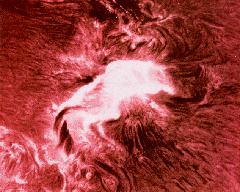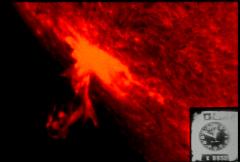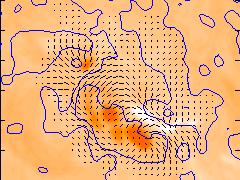

Solar Flares
| Flare CharacteristicsSolar flares are tremendous explosions on the surface of the Sun. In a matter of just a few minutes they heat material to many millions of degrees and release as much energy as a billion megatons of TNT. They occur near sunspots, usually along the dividing line (neutral line) between areas of oppositely directed magnetic fields. Flares release energy in many forms - electro-magnetic (Gamma rays and X-rays), energetic particles (protons and electrons), and mass flows. Flares are characterized by their brightness in X-rays (X-Ray flux). The biggest flares are X-Class flares. M-Class flares have a tenth the energy and C-Class flares have a tenth of the X-ray flux seen in M-Class flares. The National Oceanic and Atmospheric Administration (NOAA) monitors the X-Ray flux from the Sun with detectors on some of its satellites. Observations for the last few days are available at NOAA's website for Today's Space Weather. | ||||
| Flare ObservationsSolar flares are often observed using filters to isolate the light emitted by hydrogen atoms in the red region of the solar spectrum (the H-alpha spectral line). Most solar observatories have H-alpha telescopes and some observatories monitor the Sun for solar flares by capturing images of the Sun every few seconds. The images at the left are from the Big Bear Solar Observatory. The image at the upper left shows material erupting from a flare near the limb of the Sun on October 10th, 1971. The 4.2MB mpeg movie of this flare shows how material is blasted off of the Sun within just a few minutes. The image at the lower left shows a powerful flare observed on the disk of the Sun on August 7th, 1972. This is an example of a "two-ribbon" flare in which the flaring region appear as two bright lines threading through the area between sunspots within a sunspot group. (See the 2.2MB mpeg movie.) This particular flare, the "seahorse flare," produced radiation levels that would have been harmful to astronauts if a moon mission had been in progress at the time. | ||||
| Flares and Magnetic ShearThe key to understanding and predicting solar flares is the structure of the magnetic field around sunspots. If this structure becomes twisted and sheared then magnetic field lines can cross and reconnect with the explosive release of energy. In the image to the left the blue lines represent the neutral lines between areas of oppositely directed magnetic fields. Normally the magnetic field would loop directly across these lines from positive (outward pointing magnetic field) to negative (inward pointing magnetic field ) regions. The small line segments show the strength and direction of the magnetic field measured with the MSFC Vector Magnetograph. These lines and line segments overlie an image of a group of sunspots with a flaring region. The flare (the bright area) lies along a section of a neutral line where the magnetic field is twisted (or sheared) to point along the neutral line instead of across it. We have found that this shear is a key ingredient in the production of solar flares. |


























No hay comentarios:
Publicar un comentario